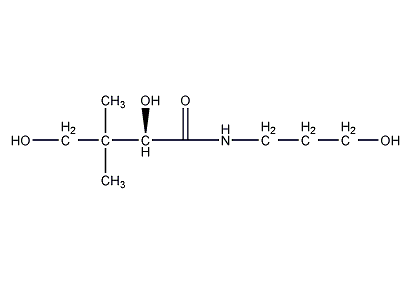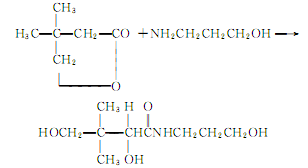
Structural formula
| Business number | 01RU |
|---|---|
| Molecular formula | C9H19NO4 |
| Molecular weight | 205.25 |
| label |
(R)-(+)-2,4-Dihydroxy-N-(3-hydroxypropyl)-3,3-dimethylbutyramide, D-Panthenol, D-Pantothenyl alcohol, Panthenol; Vitamin B5, Optically active substances |
Numbering system
CAS number:81-13-0
MDL number:MFCD00065006
EINECS number:201-327-3
RTECS number:ES4316000
BRN number:1724947
PubChem number:24869958
Physical property data
1. Properties: Colorless viscous oily liquid. Slightly bitter taste. Slightly hygroscopic.
2. Density (g/mL, 25/4℃): 1.20
3. Relative vapor density (g/mL, air=1): No Determined
4. Melting point (ºC): Uncertain
5. Boiling point (ºC, normal pressure): 118-120°C
6. Boiling point ( ºC, 5.2kPa): Uncertain
7. Refractive index: 1.495-1.502
8. Flash point (ºC): Uncertain
9. Ratio Optical rotation (º): 30.5° (c=5, H2O on anh. sub)
10. Autoignition point or ignition temperature (ºC): Uncertain
11. Vapor Pressure (kPa, 25ºC): Uncertain
12. Saturated vapor pressure (kPa, 60ºC): Uncertain
13. Heat of combustion (KJ/mol): Uncertain
p>
14. Critical temperature (ºC): Uncertain
15. Critical pressure (KPa): Uncertain
16. Oil-water (octanol/water) partition coefficient The logarithmic value of p>
19. Solubility: Easily soluble in water, ethanol and methanol, slightly soluble in ether
Toxicological data
1. Acute toxicity
Mouse caliber LC50: 15mg/kg; Mouse abdominal LC50: 9mg/kg;
Mouse intravenous LC50: 7mg/kg;
p>
Rabbit intravenous LD50: 4mg/kg;
2. Neurotoxicity
Rabbit skin test: 500mg/24H; Rabbit eye test: 500 ugREACTION SEVERITY
Ecological data
None yet
Molecular structure data
1. Molar refractive index: 51.89
2. Molar volume (cm3/mol): 175.9
3. Isotonic specific volume (90.2K ): 465.9
4. Surface tension (dyne/cm): 49.1
5. Polarizability (10-24cm3): 20.57
Compute chemical data
1. Hydrophobic parameter calculation reference value (XlogP): -0.9
2. Number of hydrogen bond donors: 4
3. Number of hydrogen bond acceptors: 4
4. Number of rotatable chemical bonds: 6
5. Number of tautomers: 2
6. Topological molecular polar surface area (TPSA): 89.8
7. Number of heavy atoms: 14
8. Surface charge: 0
9. Complexity: 182
10. Isotopic atoms Quantity: 0
11. Determine the number of atomic stereocenters: 1
12. Uncertain number of atomic stereocenters: 0
13. Determine the chemical bond structure Number of stereocenters: 0
14. Number of uncertain chemical bond stereocenters: 0
15. Number of covalent bond units: 1
Properties and stability
It is stable under normal temperature and pressure.
Storage method
This product should be stored in a sealed, cool, dry place away from light.
Synthesis method
1. Mix D-pantolactone and 3-aminopropanol in methanol and condense them. The response is as follows:

Purpose
1. Widely used in medicine, food, cosmetics and liquid preparations.
2.Panthenol can be converted into pantothenic acid in the hair and skin, which penetrates deep into the hair roots and penetrates the skin to keep the moisture in the hair and skin dry. Affected by the air, it prevents dandruff caused by over-drying of hair, effectively reduces hair splits, and repairs damage caused by chemicals or machinery (such as perming, hair dyeing, styling, combing, etc.). Gives hair luster, lubrication and reduces tangles. In cream products, it can stimulate cell division and proliferation, promote normal keratinization, promote wound healing, anti-inflammatory, moisturizing, and preventive and curative effects on severe sun exposure. Due to the above characteristics, it can be used in creams, lotions and liquids used on the face and body. The recommended dosage is 0.5% to 5%. The recommended dosage for cosmetics such as lipstick and lipstick is 1% to 5%. For hair products, such as shampoo, conditioner, hair conditioner, mousse and spray hair conditioner, the recommended dosage is 1% to 5%. The dosage for non-cleanable products is 0.1% to 0.5%. The dosage of cleaning supplies after use is 2% to 5%.

 微信扫一扫打赏
微信扫一扫打赏

